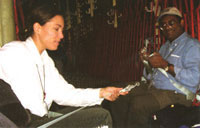CDC’s Epidemic Intelligence Service: The Real Medical Investigators (web article)
 Epidemic Intelligence Service (EIS) officer Ilin Chuang packed a suitcase the night of September 11, 2001.
Epidemic Intelligence Service (EIS) officer Ilin Chuang packed a suitcase the night of September 11, 2001.
As an officer of the CDC's corps of frontline responders, she expected a call, and her intuition proved correct.
“The CDC shipped 34 of us to the city on September 14, in a freezing, noisy, military cargo plane,” she remembered. “When we finally flew over Manhattan and saw the smoke and no towers, we all got very quiet.”
Chuang, MD, MPH, LCDR, took part in a number of other dramatic investigations for the EIS, from helping to investigate the first death in Florida from the anthrax mail attack to living inside a Pennsylvania prison while battling a group A streptococcal pharyngitis outbreak. She spoke about the EIS at the Johns Hopkins Bloomberg School of Public Health August 26, as part of a series of information sessions for MPH students sponsored by the School's Master of Public Health Program.
“I joined EIS because I wanted to get the whole spectrum of epidemiologic research,” she said. “EIS not only offers outbreak experience but data collection and analysis as well.” She said that all EIS officers are given the chance to apply epidemiologic skills in outbreak studies and that training is comprehensive and hands-on.
Begun in 1951 by Alexander Langmuir, MD, MPH '40, the EIS retains a special connection to the School, with such School luminaries as Dean Alfred Sommer and professors Robert Lawrence and Bernard Guyer having been EIS officers in years past. Langmuir, a former associate professor of Epidemiology at the School, established the Epidemic Intelligence Service in 1951 following the start of the Korean War as an early-warning system against biological warfare and man-made epidemics. The program, composed of professionals who serve for 2 years, has since expanded into a surveillance and response unit for all types of epidemics, including chronic disease and injuries.
Usually 300 to 400 applicants vie each year for 60 to 80 EIS positions, said Chuang. To apply, they must have earned either an MPH or an advanced degree such as an MD or JD, a PhD or DrPH, or a nursing degree. (An MPH is not required—although desirable—for those candidates with doctoral degrees.) A variety of professionals choose to become EIS officers. “We've had park rangers, medical doctors, veterinarians, dentists, lawyers, an Olympic skater, even anthropologists—it's crucial that EIS officers understand cultural differences,” said Chuang.
Chuang also said that it helps if a candidate has acquired some extra skills. “Every EIS officer has solid epidemiologic and investigative training, so whatever extra language or cultural experience you have by living in other countries can help you stand out.” She believes her foreign language skills (besides English, she speaks fluent Mandarin Chinese and Taiwanese) helped her get chosen for duty in New York City after 9/11.
Once on the ground in New York on September 14, she and her team members dispersed throughout lower Manhattan to set up surveillance systems within 15 existing hospital emergency departments. In 12-hour shifts, they collected data on the demographics and symptoms of every person who walked in, looking for any unusual blips or trends in the data that might indicate a outbreak of disease, or even a bioterrorism attack. “We might, for instance, investigate a little respiratory outbreak to determine if the illness was acute and transmissible, or just a chronic condition that had flared up.”
To apply to the EIS, applicants must send in their CV, transcripts, letters of recommendation and a statement of purpose by September 15 of each year. Asked about how much the average EIS officer travels, Chuang said, “You can choose to do zero travel, or to cover outbreaks anywhere in the world—it's amazing they can actually send you anywhere in the world within hours.” Two-thirds of EIS officers are based in Atlanta; the rest are dispersed around the U.S. and Puerto Rico.
The experience gained during EIS service is irreplaceable, said Chuang. To successfully graduate from the program, every EIS officer must: perform a number of field investigations, from acute outbreaks to chronic disease; present findings at a national conference; and get their research published in a peer-reviewed journal and in the CDC's Morbidity and Mortality Weekly Report.
“Before I started at EIS, a part of me thought I was crazy to get more training," said Chuang. "But after investigating my first large-scale outbreak, I realized we EIS people were necessary when local resources become overwhelmed. Although local public health workers investigate the majority of outbreaks, if EIS officers didn't investigate the large-scale ones, nobody would—local agencies just don't have the resources to do it.” —Rod Graham
